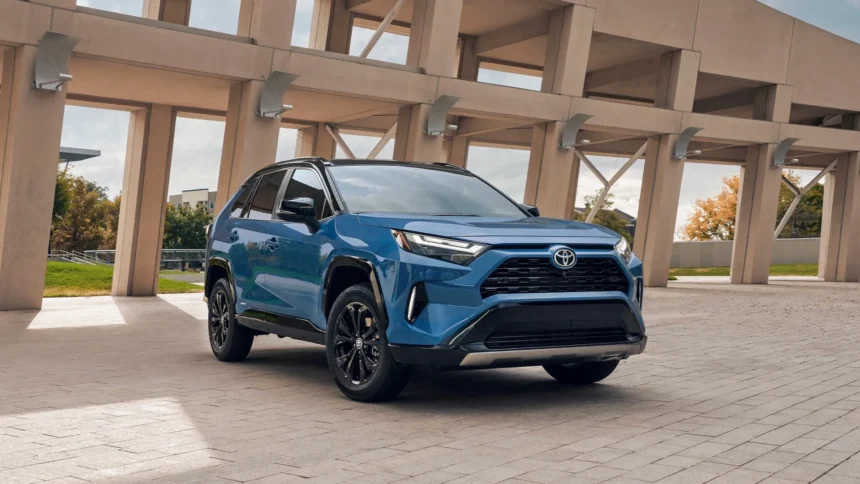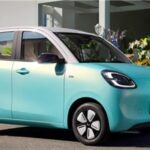The 2025 Toyota RAV4 and 2025 Nissan Rogue are two popular compact crossover SUVs that offer a perfect blend of affordability, efficiency, spaciousness, and versatility. These vehicles have become favorites among shoppers due to their higher seating position, ease of getting in and out, and reconfigurable interior for both passengers and cargo. They provide a car-like ride and handling with a hint of ruggedness and increased ground clearance. Additionally, the top-equipped versions of both models are priced well below the average cost of a new vehicle, which is steadily climbing towards $50,000.
The RAV4 stands out for its value proposition, especially with the performance and efficiency boost of its hybrid system. However, when comparing the two models, which one comes out on top?
Nissan Rogue vs. Toyota RAV4: Prices and Features
- Both models have a starting price of around $30,000
- The RAV4 is available in hybrid and Prime plug-in hybrid versions
- Top picks include the Rogue SL, RAV4 Hybrid SE, and RAV4 Prime SE
Nissan Rogue Pricing and Features
The Nissan Rogue starts at approximately $30,000 for the base S trim level. It comes with an 8.0-inch touchscreen with Apple CarPlay and Android Auto, cloth seats, and automatic emergency braking. The lineup includes SL and SV versions, with the top-trim Platinum starting at around $42,000. All-wheel drive can be added to any trim for an additional $1,400.
The Rogue offers a limited options list, with comfort-oriented features and tech upgrades available. The Rogue SL provides the best value with 19-inch wheels, leather upholstery, a 12.3-inch touchscreen, and the option to add a Premium Package with a power tailgate and Bose audio.
Toyota RAV4 Pricing and Features
The Toyota RAV4 lineup starts at about $30,000 for the base LE and goes up to over $50,000 for a fully-loaded RAV4 Prime XSE. The base LE model shares similar standard features with the Rogue, but offers wireless smartphone connectivity and standard adaptive cruise control.
The RAV4 hybrid models are all-wheel drive and start with the Hybrid LE at around $33,000. The non-Prime RAV4 lineup tops out with the Hybrid Limited at $41,600, which can be configured to around $45,000 with additional features like a panoramic roof and heated seats.
The RAV4 comes in various models, including LE, XLE, SE, XSE, and Limited, with the SE track offering a sportier look and more tech-focused equipment. The Hybrid SE is a great mid-level option for value at approximately $36,000.
Advantage: Toyota RAV4 – The RAV4 stands out for offering a high-mpg hybrid with AWD without a significant price premium.
Toyota RAV4 vs. Nissan Rogue: Size, Seating Capacity, and Cargo Space
- Rogue and RAV4 are similar in size with slight differences in dimensions
- Rogue offers more passenger volume, while RAV4 has more cargo space
- Rogue has better seats and makes more use of available space
The Nissan Rogue, Toyota RAV4, and other close rivals like the 2025 Honda CR-V and 2025 Subaru Forester are all sized within an inch or two of each other in key dimensions. The RAV4 has a wheelbase of about 106 inches and measures around 181 inches long, 73 inches wide, and 67 inches high in its most popular versions. On the other hand, the Rogue measures about 183 inches long, 72 inches wide, and 67 inches high, with a wheelbase of about 107 inches.
In terms of passenger volume, the Rogue surpasses the RAV4 with over 105 cubic feet compared to the RAV4’s 99 cubic feet. The Rogue feels more spacious and airy, while the RAV4 may have a higher floor relative to the roofline. However, when it comes to cargo space, the RAV4 offers slightly more with 37.5 cubic feet with the seats up and around 70 cubic feet behind the front seat when the seats are folded down.
While the cabin space measurements may not show a significant difference, real-world usability varies. The RAV4 has decent front seats, while the Rogue offers more supportive seating for a comfortable ride.
In conclusion, both the 2025 Toyota RAV4 and 2025 Nissan Rogue have their strengths and advantages, making them popular choices in the compact crossover SUV segment. Shoppers looking for a blend of affordability, efficiency, and versatility will find these models to be compelling options in the market. The Toyota RAV4, on the other hand, offers a more engaging driving experience with responsive handling and a comfortable ride quality. The RAV4 Hybrid models stand out for their all-wheel drive capability and improved drivability compared to the base gasoline models.
In terms of performance, the Nissan Rogue’s turbo-3 engine and CVT transmission provide smooth acceleration but may feel sluggish during passing maneuvers. In comparison, the RAV4’s 2.5-liter inline-4 engine paired with an 8-speed automatic transmission delivers adequate power for daily driving. However, the real performance standout in the RAV4 lineup is the hybrid version, which offers a combined 219 horsepower and impressive acceleration.
For those seeking even more performance, the RAV4 Prime stands out with its plug-in hybrid technology, offering 42 miles of all-electric driving range and a quick 0-60 mph time of 5.7 seconds. This makes the RAV4 Prime not only a fuel-efficient eco-warrior but also a performance flagship in the lineup.
Overall, the Nissan Rogue and Toyota RAV4 offer different driving experiences, with the Rogue focusing on comfort and refinement while the RAV4 emphasizes performance and efficiency. Whether you prioritize a smooth ride or engaging driving dynamics, both SUVs have something to offer in terms of performance. The Toyota RAV4 is a versatile SUV with a range of trim levels and powertrain options to suit different preferences. However, some critics feel that the RAV4 can be less nimble and coordinated compared to its competitors. Despite this, the RAV4 has some advantages, especially when it comes to its all-wheel-drive hybrid power. The RAV4 Prime, in particular, stands out for its perky performance and impressive fuel efficiency.
When it comes to fuel economy, the RAV4 Hybrid versions shine, with most models getting 40 mpg combined. The RAV4 Prime, with its 42-mile electric range, still manages an impressive 38 mpg combined once the electric charge is depleted. On the other hand, the Nissan Rogue offers good efficiency with its turbo-3 engine, especially in base versions.
In terms of interior and technology, both the Nissan Rogue and Toyota RAV4 offer large touchscreens and solid infotainment systems with Apple CarPlay and Android Auto. The Rogue has a more upscale look and feel in the cabin, especially in higher trims like the Platinum. However, the RAV4 has some advantages, such as adaptive cruise control being standard on all models and a range of screen sizes available depending on the trim level.
Overall, the Toyota RAV4 edges out the Nissan Rogue in terms of performance, efficiency, and safety, earning a higher rating in reviews. While the Rogue excels in features and comfort, the RAV4 stands out for its overall package. In conclusion, the Toyota RAV4 is the winner in this comparison, offering a compelling combination of performance, efficiency, and safety features. The Importance of Mental Health in the Workplace
In today’s fast-paced and high-stress work environments, it is more important than ever to prioritize mental health in the workplace. Mental health issues can have a significant impact on employee well-being, productivity, and overall job satisfaction. Employers have a responsibility to create a supportive and inclusive work environment that promotes mental health and well-being.
One of the key reasons why mental health in the workplace is so important is because it directly impacts employee performance. When employees are struggling with mental health issues such as anxiety, depression, or burnout, their ability to focus, make decisions, and complete tasks can be greatly compromised. This can lead to decreased productivity, increased absenteeism, and ultimately, a negative impact on the bottom line.
Furthermore, mental health issues can also affect employee morale and job satisfaction. When employees are not feeling their best mentally, they are less likely to be engaged and motivated in their work. This can lead to feelings of disengagement, frustration, and even resentment towards the company. On the other hand, when employees feel supported and valued in the workplace, they are more likely to be happy, engaged, and productive.
Creating a mentally healthy workplace involves implementing a range of strategies and initiatives. This can include providing access to mental health resources and support services, promoting work-life balance, and fostering a culture of open communication and support. Employers can also offer mental health awareness training for managers and employees to help reduce stigma and increase understanding of mental health issues.
In addition to supporting individual employees, it is also important for employers to address systemic issues that may contribute to poor mental health in the workplace. This can include addressing issues such as excessive workload, unrealistic expectations, workplace bullying, and lack of support from management. By addressing these underlying issues, employers can create a more positive and supportive work environment that promotes mental well-being for all employees.
Overall, mental health in the workplace is a critical issue that cannot be ignored. Employers have a responsibility to prioritize mental health and well-being in the workplace in order to support their employees, improve performance, and create a positive and inclusive work environment. By taking proactive steps to promote mental health, employers can help to create a more productive, engaged, and successful workforce.







